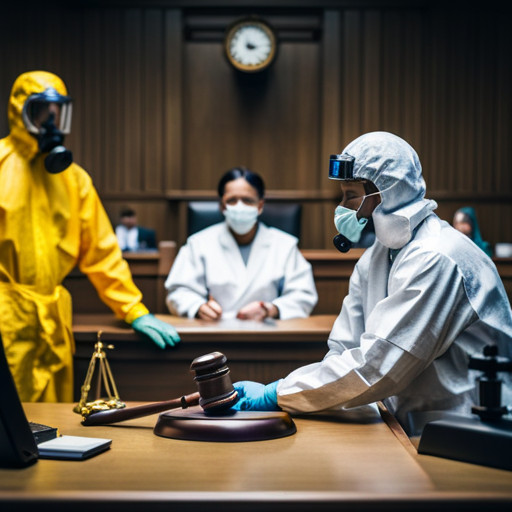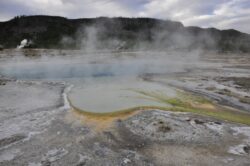The Benefits of Joining a Class Action Lawsuit for Environmental Injustice
This article offers an in-depth exploration of the process involved in filing a chemical exposure class action lawsuit. It is designed to provide detailed insights into each critical stage of the legal process, from identifying the responsible party and gathering evidence of negligence to documenting injuries and medical treatment.

The article further elucidates the importance of retaining a skilled legal representative, determining the appropriate legal strategy, submitting the legal documents, preparing for court proceedings, and negotiating a settlement.
An understanding of rights and responsibilities in such cases is also underscored. The content within aims to enhance the reader's knowledge of this complex legal procedure, thereby equipping potential plaintiffs with the necessary information to navigate this challenging terrain.
The objective is not only to inform but also to empower those who may have been adversely affected by chemical exposure incidents.
Key Takeaways
- Identifying the responsible party is crucial in filing a chemical exposure class action lawsuit.
- Gathering evidence of negligence and documenting injuries and medical treatment is essential in building a strong case.
- Retaining a skilled legal representative is important to navigate the complexities of a class action lawsuit.
- Submitting meticulous and legitimate legal documents is crucial for the success of the lawsuit.
Identifying the Responsible Party
In the initiation of a chemical exposure class action lawsuit, a critical step involves identifying the party responsible, typically a corporation or entity that has allegedly caused the exposure through negligence or failure to adhere to safety standards. This process, often complex, necessitates a thorough investigation to establish party accountability, a central factor in such lawsuits. This phase is crucial as it sets the groundwork for the entire case, determining the party or parties who will be held legally liable for the alleged exposure.
The process of identifying the responsible party involves an extensive analysis of the circumstances leading up to the suspected exposure. This may include an evaluation of company records, product information, safety protocols, and workplace conditions. Legal liabilities are determined based on the evidence gathered, and may involve multiple parties, depending on the findings. If a company failed to follow safety regulations, for instance, it may be held liable. However, if a third-party contractor was responsible for implementing safety measures, they might also share the liability.
An accurate identification of the responsible party or parties is not only essential to the success of the lawsuit but also plays a crucial role in ensuring that similar incidents are prevented in the future. It brings to light instances of negligence or disregard for safety regulations, prompting changes in industry practices. Thus, this step not only serves a legal purpose, but also a broader societal one, contributing to the overall enhancement of safety standards and practices in industries dealing with chemical substances.
This crucial phase in the lawsuit process, therefore, is integral to both justice and preventative measures.
Gathering Evidence of Negligence
Compiling substantial and indisputable evidence of negligence remains a critical step towards building a formidable case in the realm of environmental litigation. This stage, referred to as negligence proofing, involves gathering a comprehensive body of evidence to substantiate the claim that the responsible party failed in their obligation to ensure a safe environment, ultimately leading to the chemical exposure incident.
Evidence collection is a meticulous process that demands the expertise of various professionals, including environmental scientists, medical practitioners, and legal experts. This interdisciplinary team collaboratively works to collect and analyze relevant data, strengthening the foundation of the lawsuit. The evidence generally consists of scientific data documenting the presence of hazardous chemicals, records of safety violations, witness testimonies, and medical records confirming health impacts due to exposure.
Conducting site inspections and obtaining samples for laboratory testing can be instrumental in establishing the link between the exposure and the chemicals present in the environment. Simultaneously, scrutinizing the responsible party's conduct, safety protocols, and incident response can reveal instances of negligence or non-compliance with environmental regulations.
Medical records serve as crucial evidence in demonstrating the tangible impact of the exposure on victims' health. Expert testimonies from doctors and epidemiologists can further corroborate these findings, providing a direct connection between the chemical exposure and ensuing medical disorders.
The process of evidence collection and negligence proofing, while arduous, is paramount in the pursuit of justice for chemical exposure victims. A well-documented, scientifically substantiated case not only bolsters the plaintiffs' claim but also sends a strong message about the gravity of environmental negligence, fostering a culture of accountability and safety.
Documenting Your Injuries and Medical Treatment
Documenting the physical and psychological effects of environmental negligence is a crucial step towards establishing the extent of harm inflicted upon the victims. In the context of a chemical exposure class action lawsuit, this process of Injury Documentation is instrumental in generating a comprehensive record of the afflictions suffered by the plaintiffs.
The management of Medical Records is a significant factor in this process. It involves the collection and organization of all relevant medical documents that provide evidence of the injuries and medical treatment received by the victims. These documents can include medical reports, prescriptions, laboratory test results, X-rays, CT scans, and other diagnostic reports. Detailed medical records provide a potent testament to the physical and psychological damage caused by the chemical exposure.
Moreover, documenting the progression of the injuries and the subsequent medical treatment can reveal patterns in the health consequences of the chemical exposure. It can help establish a causal link between the negligent act and the harm suffered by the victims, strengthening the plaintiffs' case. It is essential that all medical appointments, treatments, and diagnoses related to the exposure are thoroughly documented.
Medical Records Management also requires the maintenance and preservation of these records over time, ensuring their accessibility for future reference. This is particularly important in a class action lawsuit, where the evidence needs to be robust and compelling to represent the claims of a large group of victims.
Thus, effective Injury Documentation and Medical Records Management are critical components in the process of filing a chemical exposure class action lawsuit. These provide the tangible proof of harm required to substantiate the victims' claims and bolster their pursuit of justice.
Retaining a Skilled Legal Representative
Securing the services of a competent legal representative is a crucial step in seeking redress for harm caused by environmental negligence. The process of filing a chemical exposure class action lawsuit requires specialized knowledge and considerable resources. Therefore, the selection of a legal representative is a decision that should not be taken lightly.
Legal representative selection is a complex process, involving careful consideration of multiple factors. The representative's experience, qualifications, and track record in handling similar cases are of utmost importance. As chemical exposure lawsuits often involve sophisticated scientific and medical issues, a legal representative with relevant experience can navigate these complexities effectively. Additionally, such a representative is more likely to have established relationships with expert witnesses who can provide crucial testimony in these cases.
The importance of a representative's experience cannot be overstated. A representative who has successfully handled similar cases in the past will be familiar with the legal strategies and arguments that are most likely to lead to a favorable outcome. Moreover, an experienced representative will be able to anticipate and effectively counter the arguments and tactics employed by the defendant's legal team.
It is also crucial to consider the resources that a legal representative can bring to bear on the case. Chemical exposure class action lawsuits often require significant financial resources to conduct in-depth investigations, hire expert witnesses, and prepare comprehensive legal arguments. Therefore, a legal representative with a strong financial backing and a dedicated team can significantly increase the chances of success.
While seeking justice for harm caused by chemical exposure, the importance of retaining a skilled and experienced legal representative must not be underestimated. The right representative can make a significant difference in achieving a favorable resolution.
Determining the Appropriate Legal Strategy
Mapping out an effective legal strategy is an essential step in pursuing justice for damages caused by environmental negligence. Legal Strategy Analysis provides the foundation for the development of a robust plan, which is required to tackle the complexities of a chemical exposure class action lawsuit. This process encompasses understanding the nature of the exposure, identifying potentially responsible parties, and assessing the strength of the available evidence.
Crafting the right legal strategy involves thorough analysis of the case facts, assessment of the applicable law, and the identification of the most effective legal theories to pursue. Class action lawsuits can be particularly complex due to their multi-jurisdictional nature and the large number of affected parties. Therefore, the legal strategy must address these complexities, including the potential for differing legal standards across jurisdictions and the challenge of coordinating a large group of plaintiffs.
The legal strategy should also anticipate and prepare for Strategy Implementation Challenges. These may include the possibility of protracted litigation, the substantial financial resources required, and the need for detailed expert evidence. The necessity to prove causation – the link between the exposure and the harm suffered by the plaintiffs – is another significant challenge that requires careful strategic planning.
Ultimately, a well-crafted legal strategy provides the pathway to justice for those harmed by chemical exposure. It is the roadmap that guides the litigation, highlighting the key issues, identifying potential obstacles, and setting out the steps required to overcome them. This strategic approach is fundamental to the successful prosecution of a chemical exposure class action lawsuit.
Forming a Group of Claimants
Establishing a cohort of claimants is a critical step in pursuing legal recourse for environmental negligence, as it allows the collective strength of multiple affected parties to be harnessed effectively. This phase requires a careful approach to claimant recruitment, emphasizing the importance of group dynamics. The formation of a cohesive group of claimants can increase the chances of achieving a favorable legal outcome, as a united front can present a stronger case against alleged perpetrators.
The process of claimant recruitment involves identifying individuals who have potentially been affected by the chemical exposure in question. This can be achieved through various methods, such as public announcements, advertisements, and outreach programs. Moreover, it is essential to establish a clear communication channel among claimants to ensure information dissemination and coordination effectively.
The role of group dynamics in this process cannot be understated. It is important to foster a sense of unity and solidarity among the group. This collective identity can help to strengthen the resolve of the claimants and improve their ability to withstand potential legal and psychological pressures during the course of the lawsuit. Moreover, a strong group dynamic can facilitate the sharing of information and experiences among claimants, which can contribute to building a robust and compelling case.
In the legal journey of a chemical exposure class action lawsuit, forming a group of claimants stands as a significant milestone. It is a complex, yet critical process that can influence the trajectory and outcome of the lawsuit. Therefore, meticulous attention to claimant recruitment and effective management of group dynamics are indispensable components of this process.
Submitting the Legal Documents
Navigating the intricacies of legal documentation demands a meticulous approach, where each document is systematically prepared and submitted, serving as a tangible embodiment of the claimants' collective grievances and their quest for justice. At this stage, the component of document authentication assumes significant importance, ensuring the legitimacy and veracity of all the submitted legal documents. This process extends beyond simple verification, involving a rigorous examination of each detail to ascertain its credibility.
The process commences with the drafting of the complaint, a formal legal document that outlines the claims made by the affected group. It meticulously details the alleged harm caused by the defendant, including specific instances of chemical exposure, the resultant injuries, and the legal basis for liability. The complaint must be presented in clear, concise legal terminology which accurately communicates the claimants' grievances.
Following the complaint, other pivotal documents are prepared. These may include affidavits from medical professionals substantiating the health implications of the chemical exposure, expert testimonies to establish a link between the exposure and the defendant's actions, and any relevant documentary evidence to reinforce the claimants' case. Each of these documents undergoes a stringent process of authentication.
The process culminates in the submission of these documents to the appropriate court. It is paramount that this submission adheres to the relevant court rules and filing procedures. Any discrepancies or omissions can lead to the dismissal of the case, underscoring the necessity for meticulous attention to detail in this phase.
Thus, the submission of legal documents is a crucial step that encapsulates the allegations, evidence, and legal reasoning that underpin a chemical exposure class action lawsuit.
Preparing for Court Proceedings
Transitioning into the court proceedings phase necessitates a comprehensive strategy, built upon a robust understanding of the legal landscape, to effectively articulate and substantiate the grievances of the claimants. The preparation phase involves a meticulous analysis of the lawsuit's merits, potential defenses, and a concrete plan to present the case convincingly. In this phase, both courtroom etiquette and witness preparation become crucial.
Courtroom etiquette entails adhering to a set of formalities and procedures that maintain decorum and respectful interaction within the court. It involves aspects such as timely arrival, appropriate attire, respectful communication, and maintaining decorum while presenting the case. A breach of such etiquette can be seen as disrespectful and could potentially harm the case's standing.
Witness preparation, on the other hand, is a process that readies witnesses for their appearance in court. This preparation includes familiarizing them with the court proceedings, rehearsing their testimonies, and equipping them with strategies to handle cross-examination. Witnesses should be able to recount their experiences clearly and consistently, as their testimonies can significantly influence the court's perception of the case.
In the process of preparing for court proceedings, strategies should be developed to address any potential weaknesses in the case. Additionally, the legal team should familiarize themselves with the judge's previous rulings and tendencies to better anticipate potential legal arguments.
This stage of the process demands a thorough understanding of legal protocols, an ability to construct compelling arguments, and an extensive preparation of the witnesses. These factors collectively contribute to formulating a strong stance in court, thereby increasing the chances of a favorable outcome for the claimants.
Negotiating a Settlement
Transitioning from the meticulous preparations for court proceedings, the evolution of a chemical exposure class action lawsuit moves towards a potentially more amicable phase: negotiating a settlement. This stage presents both opportunities and challenges, requiring a strategic approach to maximize the benefits and minimize the pitfalls.
Significant emphasis is placed on the negotiation process due to its potentially decisive role in determining the outcome of the lawsuit. This process is not without its pitfalls, as the complexity of chemical exposure cases can lead to settlements that do not adequately compensate the victims for their losses. These pitfalls can include underestimation of long-term medical costs, disregard for non-economic damages such as emotional distress, and the pressure to accept a quick settlement to avoid lengthy litigation.
To navigate these challenges, the lawsuit participants may choose to engage in mediation. Mediation offers several benefits in the context of a class action lawsuit. Firstly, it allows for a neutral third-party to facilitate discussion and negotiation, reducing the risk of power imbalances affecting the outcome. Secondly, it can expedite the legal process, saving both time and resources. Lastly, mediation tends to promote a more collaborative environment, which may increase the likelihood of a fair and satisfactory settlement.
It is imperative, thus, to approach the negotiation phase with a thorough understanding of its intricacies, including awareness of potential settlement pitfalls and appreciation for the benefits of mediation. This knowledge empowers parties to make informed decisions, fostering the possibility of an equitable resolution to the class action lawsuit.
Understanding Your Rights and Responsibilities
Grasping the breadth and depth of your rights and responsibilities in the intricate web of legal proceedings is a crucial step towards ensuring a fair and comprehensive resolution. Understanding the implications of a chemical exposure class action lawsuit requires a thorough comprehension of Legal Awareness and Rights Exploration.
Legal Awareness is paramount in comprehending the complexities of a class action lawsuit. It involves understanding the legalities surrounding chemical exposure, the liability of the defendants, and the rights of the victims. This knowledge is essential in determining the feasibility of the case, the potential compensation, and the overall strategy to be employed during the lawsuit.
Rights Exploration, on the other hand, focuses on identifying and understanding the rights of the victims. It involves a comprehensive examination of the rights to health, a safe environment, and compensation in the event of harm caused by chemical exposure. This exploration allows victims to understand their entitlements and seek redress in a class action lawsuit effectively.
Simultaneously, responsibilities must not be overlooked. As a plaintiff, you are obliged to provide factual, accurate information regarding your exposure and any subsequent health issues. You are also responsible for cooperating with the legal team, attending court proceedings, and making informed decisions about the case.
In the realm of chemical exposure class action lawsuits, possessing a comprehensive understanding of one's rights and responsibilities is indispensable. It serves as the foundation for a robust legal strategy and ensures that victims can make informed decisions about their case, leading to a fair and just resolution. This knowledge not only empowers victims but also contributes significantly to the success of the lawsuit.
Frequently Asked Questions
What is the general timeline for a chemical exposure class action lawsuit?
The timeline for a chemical exposure class action lawsuit can be extensive, often spanning several years. Initially, the period of lawsuit preparation involves thorough investigation of the claim, gathering evidence, and filing the lawsuit. This stage could last up to a year.
Subsequently, the process moves into settlement negotiation, which can be lengthy due to the complexity of such cases. This stage frequently takes one to two years, but in certain instances, it could extend even longer.
Are there any specific qualifications a person must meet to join the class action lawsuit?
Eligibility criteria for a chemical exposure class action lawsuit typically necessitate proof of exposure to the specific chemical in question. Additionally, claimants usually must demonstrate a direct correlation between this exposure and subsequent health problems.
The severity of these health issues may also factor into eligibility. It is imperative that potential plaintiffs consult with legal counsel to fully understand these criteria and assess their own eligibility for inclusion in the class action lawsuit.
How are the proceeds from a successful lawsuit divided among the claimants?
In a class action lawsuit, the claimant compensation structure is often determined by the court. The process involves diverse considerations, including the severity of individual damages and the total settlement amount.
Proceed distribution challenges may arise due to the varying degrees of harm suffered by claimants. Consequently, a common approach is pro-rata distribution, allocating funds proportionately according to each claimant's experienced harm.
However, the precise distribution method may vary, subject to court discretion and legal counsel advice.
Can I still file an individual lawsuit if I am part of a class action lawsuit?
In the realm of legal proceedings, the question of 'Individual vs Collective' action often arises. Notably, 'Class Action Exceptions' provide some flexibility in this regard.
While participation in a class action lawsuit typically precludes the filing of an individual suit on the same issue, exceptions do exist. Parties may opt out of the class action lawsuit, preserving their right to pursue individual litigation.
However, navigating these exceptions requires a comprehensive understanding of the intricacies of the law.
Is there any financial risk involved in joining a class action lawsuit?
Joining a class action lawsuit typically has minimal financial risk for individual participants due to the distributed nature of associated costs. However, financial implications can arise if the lawsuit is unsuccessful, as some legal costs may be distributed among participants.
A thorough risk assessment should be conducted to weigh potential outcomes. While there is potential for compensation, individuals must also consider the possibility of receiving little to no financial return, depending on the lawsuit's result.
Conclusion
In conclusion, filing a chemical exposure class action lawsuit involves intricate steps including:
- Identifying the responsible party
- Gathering evidence of negligence
- Documenting injuries and medical treatment
- Retaining skilled legal counsel
- Determining the legal strategy
- Submitting legal documents
- Preparing for court
- Negotiating a settlement
The process also entails a comprehensive understanding of one's rights and responsibilities. This method ensures the pursuit of justice for individuals who have been victims of chemical exposure.

This post has been generated by AI and was not reviewed by editors. This is Not legal advice. Please consult with an attorney.




